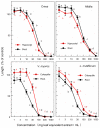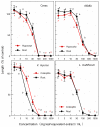Allelopathic Substances of Osmanthus spp. for Developing Sustainable Agriculture
- PMID: 36679091
- PMCID: PMC9861473
- DOI: 10.3390/plants12020376
Allelopathic Substances of Osmanthus spp. for Developing Sustainable Agriculture
Abstract
Osmanthus fragrans Lour. has been cultivated for more than 2500 years because of the fragrance and color of the flowers. The flowers and roots have been used in tea, liquors, foods, and traditional Chinese medicine. The species contains more than 180 compounds including terpenoids, phenylpropanoids, polyphenols, flavonoids, and sterols. However, there has been limited information available on the allelopathic properties and allelopathic substances of O. fragrans. We investigated the allelopathy and allelopathic substances of O. fragrans and Osmanthus heterophyllus (G.Don) P.S. Green, as well as Osmanthus × fortunei Carrière, which is the hybrid species between O. fragrans and O. heterophyllus. The leaf extracts of O. fragrans, O. heterophyllus, and O. × fortunei suppressed the growth of cress (Lepidium sativum L.), alfalfa (Medicago sativa L.), Lolium multiflorum Lam., and Vulpia myuros (L.) C.C.Gmel with the extract concentration dependently. The extract of the hybrid species O. × fortune was the most active among the extracts. The main allelopathic substances of O. × fortunei and O. fragrans were isolated and identified as (+)-pinoresinol and 10-acetoxyligustroside, respectively. (+)-Pinoresinol was also found in the fallen leaves of O. × fortunei. Both compounds showed an allelopathic activity on the growth of cress and L. multiflorum. On the other hand, several allelopathic substances including (+)-pinoresinol may be involved in the allelopathy of O. heterophyllus. O. fragrans, O. heterophyllus, and O. × fortunei are evergreen trees. but their senescent leaves fall and cover the soil under the trees. It is possible that those allelopathic substances are liberated through the decomposition process of the leaves into their rhizosphere soil, and that they accumulate in the soil and provide a competitive advantage to the species through the inhibition of the growth of the neighboring competing plants. Therefore, the leaves of these Osmanthus species are allelopathic and potentially useful for weed management options in some agriculture settings to reduce commercial herbicide dependency for the developing sustainable agriculture systems.
Keywords: (+)-pinoresinol; 10-acetoxyligustroside; Osmanthus; allelochemical; decomposition; fallen leaf; growth inhibition.
Conflict of interest statement
The authors declare no conflict of interest.
Figures









Similar articles
-
Allelopathic Effect of Osmanthus fragrans Changes the Soil Microbial Community and Increases the Soil Nutrients and the Aroma Quality of Tea Leaves.J Agric Food Chem. 2025 Jun 4;73(22):13818-13831. doi: 10.1021/acs.jafc.5c03692. Epub 2025 May 22. J Agric Food Chem. 2025. PMID: 40401704
-
Secondary Metabolites of Osmanthus fragrans: Metabolism and Medicinal Value.Front Pharmacol. 2022 Jul 18;13:922204. doi: 10.3389/fphar.2022.922204. eCollection 2022. Front Pharmacol. 2022. PMID: 35924042 Free PMC article. Review.
-
Exploration of Osmanthus fragrans Lour.'s composition, nutraceutical functions and applications.Food Chem. 2022 May 30;377:131853. doi: 10.1016/j.foodchem.2021.131853. Epub 2021 Dec 14. Food Chem. 2022. PMID: 34990948 Review.
-
Garcienone, a Novel Compound Involved in Allelopathic Activity of Garcinia Xanthochymus Hook.Plants (Basel). 2019 Aug 24;8(9):301. doi: 10.3390/plants8090301. Plants (Basel). 2019. PMID: 31450571 Free PMC article.
-
Assessment of allelopathic activity of Tradescantia spathacea Sw. for weed control.Biol Futur. 2021 Dec;72(4):489-495. doi: 10.1007/s42977-021-00098-w. Epub 2021 Sep 12. Biol Futur. 2021. PMID: 34554494
Cited by
-
Isolation and Identification of Allelopathic Substances from Forsythia suspensa Leaves, and Their Metabolism and Activity.Plants (Basel). 2024 Feb 20;13(5):575. doi: 10.3390/plants13050575. Plants (Basel). 2024. PMID: 38475422 Free PMC article.
-
Allelopathy: Mechanisms and Applications in Regenerative Agriculture.Plants (Basel). 2024 Nov 25;13(23):3301. doi: 10.3390/plants13233301. Plants (Basel). 2024. PMID: 39683093 Free PMC article.
-
Isolation and Identification of Plant-Growth Inhibitory Constituents from Polygonum chinense Linn and Evaluation of Their Bioherbicidal Potential.Plants (Basel). 2023 Apr 6;12(7):1577. doi: 10.3390/plants12071577. Plants (Basel). 2023. PMID: 37050203 Free PMC article.
References
-
- Ren Q.J., Zhu H.W., Yu J.P. The utilization value of O. fragrans resources. Chin. Wild Plant Res. 1999;18:34–35.
-
- Wu L.C., Chang L.H., Chen S.H., Fan N.C., Ho J.A. Antioxidant activity and melanogenesis inhibitory effect of the acetonic extract of Osmanthus fragrans: A potential natural and functional food flavor additive. Food Sci. Technol. 2009;42:1513–1519. doi: 10.1016/j.lwt.2009.04.004. - DOI
LinkOut - more resources
Full Text Sources
Miscellaneous

